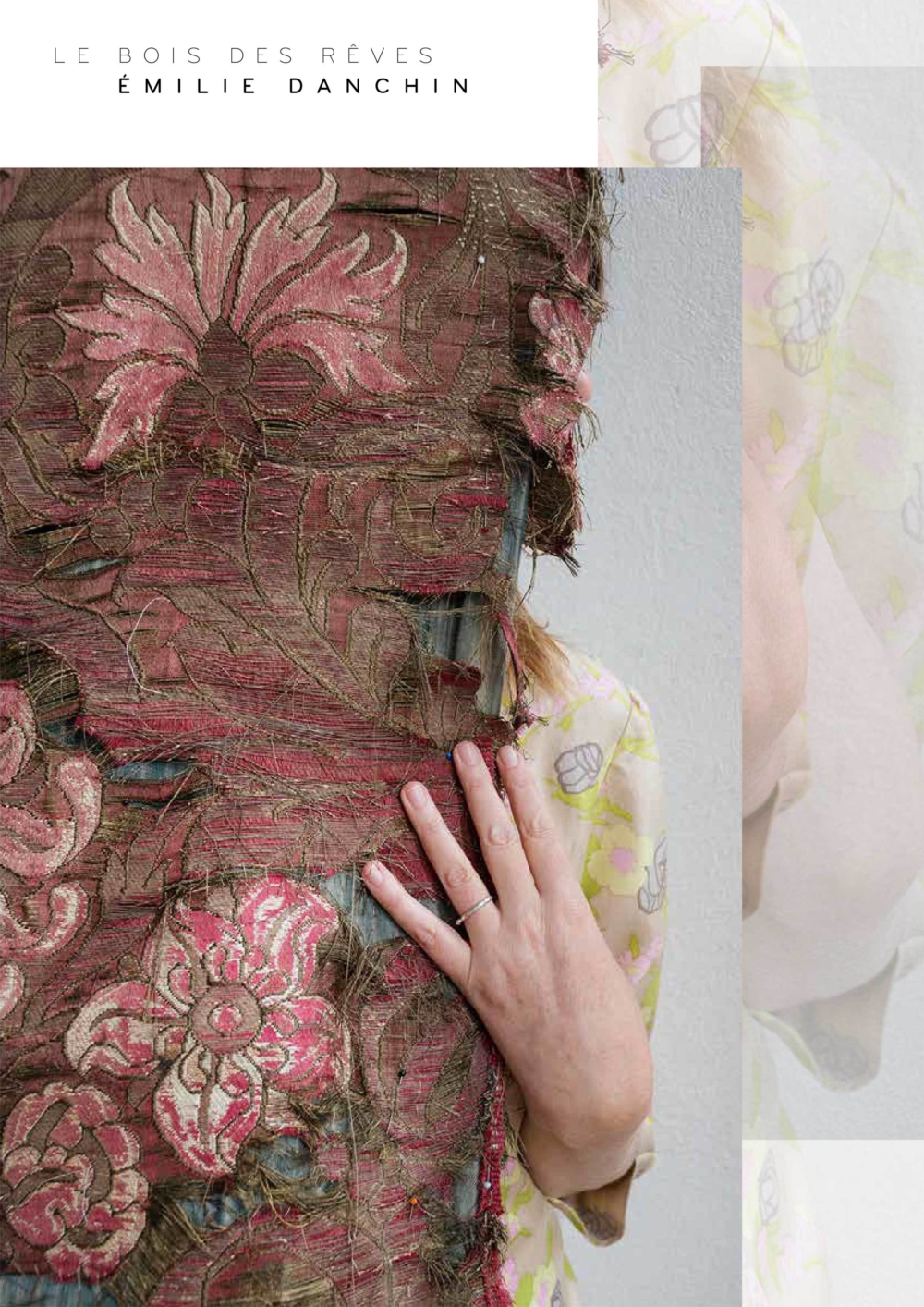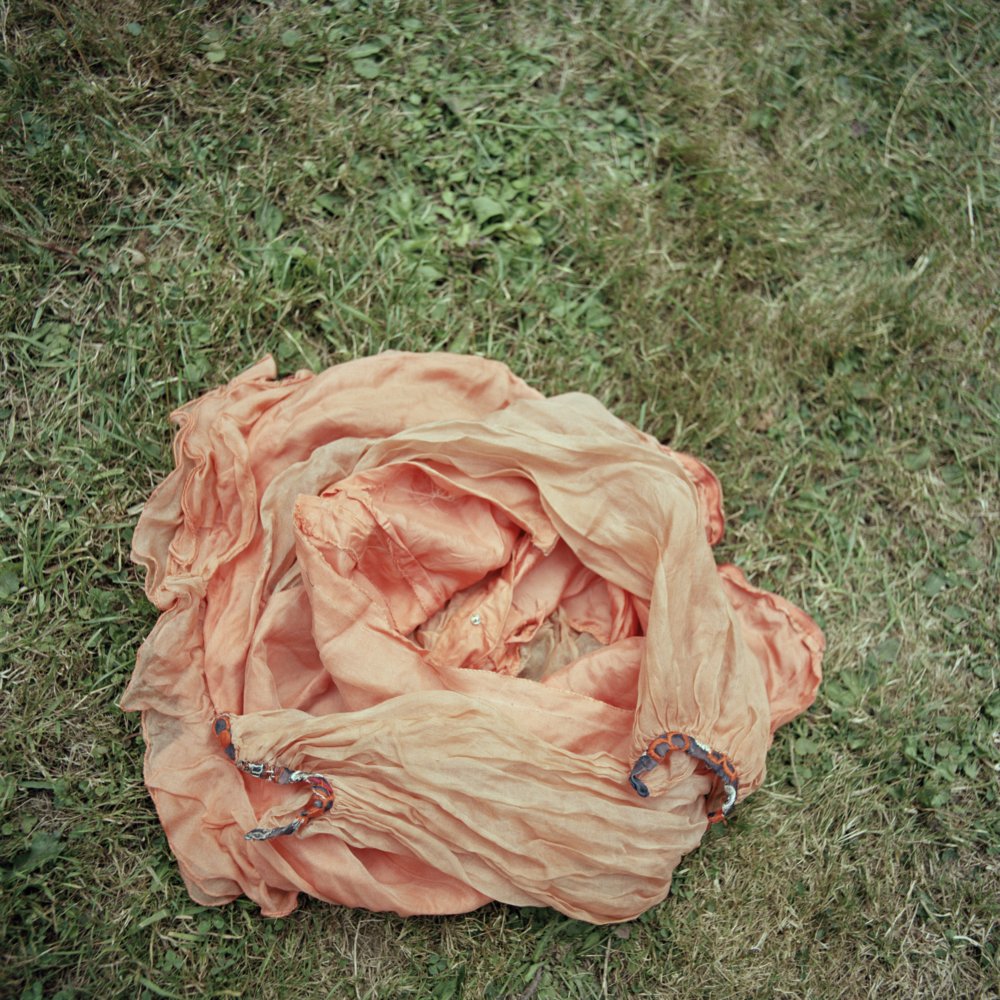Le Bois des Rêves
À Annie et Mary
Émilie Danchin exprime dans son travail des questionnements qui traitent du réalisme de la photographie en faisant intervenir le corps dans l’espace photographique. Celle-ci est vivante. C’est une aventure, et ce qu’Émilie Danchin représente est une forme de rêve éveillé, ancré dans la matière, un réel légèrement halluciné, plus ou moins habité ou animé. Dans cette perspective, l’acte photographique débouche sur une phénoménologie intime et la création progressive d’un langage plastique capable de retranscrire un vécu chargé d’images et d’affects qui, dans leur universalité, sont susceptibles d’émouvoir, de renverser la pensée et de faire rêver.
Émilie Danchin présente ici Le Bois des Rêves, le fruit d’un travail de performance et de photographie effectué dans une propriété remarquable par son architecture et ses jardins dans le style Arts and Crafts. Ce site patrimonial se prêtait à sa proposition d’investir librement un espace et un corps, le sien en l’occurrence, dans un lieu étranger qui permette d’aborder la question des origines de façon paradoxale, c’est-à-dire partant d’un lieu originel qui aurait lui-même disparu. Or, cette propriété convoquait, toutes mémoires confondues, son propre lieu de naissance anglais, les maisons grand-maternelles, leurs jardins à la campagne et à la mer, le bain, les tissus, les boiseries, les odeurs, les vêtements, les meubles, la musicalité... toute une atmosphère qui lui est globalement, culturellement familière. Et simultanément, elle rappelait l’absence, les personnes disparues, l’effraction, le vide corporel, la maison restée jusqu’il y a peu au sein d’une même famille, la perte, la filiation qui s’est interrompue.
En pratiquant l’autoportrait, Émilie Danchin s’est demandé quel visage prendrait l’intérieur de la maison. Quels émois l’extérieur de la maison traduirait-il dans les paysages qu’elle produirait ? Comment allait-elle extraire son corps de la matière pour le faire apparaître dans un paysage qui lui ressemble ? Comment le temps s’immiscerait-il dans ce lieu hypermnésique où son propre corps, son peignoir, certains de ses vêtements mêlés à ceux ayant appartenu à trois générations de femmes, la maison, le jardin, l’acte photographique lui-même sont devenus ensemble la matrice d’une capitale fiction identitaire ? Il s’agissait pour elle de fonder l’espoir d’investir un espace, sorte de double d’un autre espace imaginaire, qui puisse laisser transparaître et combler une forme d’absence, le lieu des origines, lointain et proche, inaccessible, effacé, supprimé, sorti du corps et de la maison et néanmoins, inaliénable.
Le Bois des Rêves est porté par les déclinaisons du corps de l’artiste devenu la mesure sensible de ce que le lieu pouvait susciter. Et de manière équivalente, le lieu a donné vie à des souvenirs dénués de matérialité, dont les contours un peu flous n’auraient pas pu saillir sans cette mise en scène indissociée de son corps et de l’espace. Le médium photographique, lui, est décliné dans une diversité d’aspects, le noir et blanc, la couleur, les variations de formats et d’échelles, le dialogue entre la fiction et l’observation. Il s’adjoint la vidéo. Traitée en plans fixes, celle-ci offre à l’ensemble des images une forme de durée dans le temps réel de la perception par le regard. Il en résulte une forme artistique en plusieurs temps, dont l’assemblage dans sa totalité imprime un mouvement circulaire dans l’espace et crée matériellement le temps. Intimant le désir de partir en reconnaissance, cette forme photographique épouse la volatilité de l’espace et du temps, les émotions, le rêve et le sentiment d’exister. Elle s’éprouve comme un étonnement face à la figuration de l’espace de la mémoire, dont la forme est celle du souvenir absolu et du rêve.

Le Bois des Rêves
Livre électronique, édition papier limitée disponible sur commande
Conception graphique Catherine De Cocq

Het droombos
Voor Annie en Mary
Émilie Danchin stelt in haar werk vragen over het realisme van fotografie door het lichaam in de fotografische ruimte te betrekken. Haar fotografie leeft. Het is een avontuur, en wat Émilie Danchin toont, is een vorm van wakkere droom, verankerd in de materie, een licht gehallucineerde realiteit, min of meer bewoond of geanimeerd. In dit perspectief leidt de fotografische handeling tot een intieme fenomenologie en een voortschrijdende creatie van een plastische taal. Die is in staat om een ervaring te herschrijven die geladen is met beelden en emoties die, in hun universaliteit, in staat zijn te beroeren, gedachten te verdraaien en te doen dromen.
Émilie Danchin brengt hier Het droombos, het resultaat van een performance en van fotografie uitgevoerd in een pand dat opmerkelijk is vanwege zijn architectuur en tuinen in de arts-and-craftsstijl. Deze erfgoedsite leende zich voor Danchins voorstel om zich vrijelijk meester te maken van een ruimte en een lichaam, in dit geval het hare. Ze benadert de kwestie van de oorsprong op een paradoxale manier in een vreemde plaats, dat wil zeggen vertrekkend van een originele plaats die zelf zou zijn verdwenen. Door een combinatie van herinneringen riep het pand haar eigen Engelse geboorteplaats op, de huizen van haar grootmoeders, hun tuinen op het platteland en aan zee, het bad, de stoffen, het houtwerk, de geuren, de kleding, het meubilair, de muzikaliteit ... een hele sfeer die haar algemeen cultureel bekend is. En tegelijkertijd herinnerde het aan de afwezigheid, personen die er niet meer zijn, de inbraak, de lichamelijke leegte, het huis dat tot voor kort binnen dezelfde familie bleef, het verlies, de afstamming die werd onderbroken.
Door middel van het zelfportret stelt Émilie Danchin zich de vraag welk gezicht het interieur van het huis zou krijgen. Welke emoties zou de buitenkant van het huis overbrengen in de landschappen die ze zou produceren? Hoe zou ze haar lichaam uit de materie halen om het te laten verschijnen in een landschap dat op haar lijkt? Hoe zou de tijd ingrijpen in deze plek vol herinneringen, waar haar eigen lichaam, haar badjas, sommige van haar kleren vermengd met die van drie generaties vrouwen, het huis, de tuin, de fotografische daad zelf samen het sjabloon zijn geworden van een levendig verhaal rond identiteit? Voor haar was het een kwestie van hoop te vinden om zich meester te maken van een ruimte, een soort dubbelganger van een andere denkbeeldige ruimte, die een vorm van afwezigheid zou kunnen onthullen en invullen, de plaats van oorsprong, ver en dichtbij, ontoegankelijk, gewist, verwijderd, weg van het lichaam en het huis en toch onvervreemdbaar.
Het droombos wordt gedragen door de variaties van het lichaam van de kunstenares, dat de gevoelige maat is geworden van wat de plek zou kunnen opwekken. En op een gelijkwaardige manier gaf de plek leven aan herinneringen zonder materialiteit, waarvan de enigszins vage contouren niet hadden kunnen ontstaan zonder dat deze enscenering losgekoppeld was van haar lichaam en van de ruimte. Het fotografische medium zelf wordt voorgesteld in een diversiteit aan aspecten, zwart-wit, kleur, variaties van formaten en schalen, de dialoog tussen fictie en observatie. Video komt er ook bij kijken. Die bestaat uit statische shots en verleent alle beelden een vorm van duur in realtime van waarneming door de blik. Het resultaat is een artistieke vorm in verschillende fasen, waarvan de assemblage in haar geheel een cirkelvormige beweging in de ruimte geeft en tijd creëert op een materiële wijze. Deze fotografische vorm toont het verlangen om op verkenning te gaan en omarmt de vluchtigheid van ruimte en tijd, emoties, dromen en het gevoel van bestaan. Ze verbaast als de representatie van de geheugenruimte, waarvan de vorm die van absolute herinnering en droom is.

The Wood of Dreams
To Annie and Mary
Emilie Danchin conveys questions in her work pertaining to the realism of photography by involving the body in the photographic space. It is very vibrant as well as an organic adventure. Emilie Danchin does not photograph reality as such, but a kind of dream rooted in the subject, to a certain extent a somewhat inhabited or animated dreamy reality. To this effect, the photographic act extends to a personal phenomenology and the progressive creation of a visual language. It is capable of relaying a personal experience charged with images and emotions that, universally recognisable, are likely to stir viewers’ feelings, disrupt thought and trigger dreams.
Emilie Danchin introduces here Le Bois des Rêves, the culmination of a performance and photographic work achieved in a property that is noteworthy in terms of its architecture, as well as its gardens, in the Arts-and-Crafts style. This heritage site lent itself to her proposal to have the freedom to take over a space and a body, hers in this case. She tackles the question of origins in a foreign place in a paradoxical way. It substitutes a space that no longer exists, which represents her origins.
This property conjured up, through a combination of memories, her own English place of birth, the houses belonging to her grandmothers, their gardens in the countryside and seaside, baths, smells, clothes, wooden furniture, musicality... a whole atmosphere that is generally, culturally familiar to her. And at the same time, it recalled absence, missing people, invasion and emptiness of the body and a house that until recently remained within the same family, loss and the parentage that was interrupted.
By means of self-portrait, Emilie Danchin wondered what the inside of the house would look like. How would the emotions generated by the exterior of the housee be conveyed in her outside landscapes? How would she extricate her body from the matter to render it in a landscape having similar characteristics? How would time intervene in this place full of memories where her own body, robe and some of her clothes combined with those that belonged to three generations of women, the house, garden, the photographic act itself have jointly become the template for a vivid identity-related fiction? Her aim was to found her hope of investing a space, materialising and filling a form of absence, the place of the origins. a kind of double of another imaginary space distant and close, inaccessible, erased, deleted, having left the body and the house, and nevertheless, inalienable yet.
Le Bois des Rêves is embodied by the the artist's postures, which are a sensitive measure of the evocative potential of the place. Equally, the place has given life to non-material memories, the vague outlines of which would not have stood out without this inseparable staging of her body and the space. The photographic medium is presented in a variety of aspects, black and white, colour, varying formats and scales, as well as dialogue between fiction and observation. Video also features. Processed as stills, this lends the ensemble a form of rythm in real time as such of perception through gaze. This results in an art form in several phases. As a whole, it impresses a circular motion in space and physically creates time. Intimating a desire for self-recognition, this photographic form espouses the volatility of space and time, emotions and dreams. One marvels before this representation of memory space, the autobiographical form of which is absolute memories and dreams.
Le Bois des Rêves, une vidéo réalisée à l'occasion de l'inauguration de l'exposition Le Bois des Rêves d'Émilie Danchin à la Maison de la Renaissance à la Société libre d'émulation liégeoise, avril-mai 2022.
Direction-caméra et montage : Catherine De Cocq
Soundtrack : Romain Smets